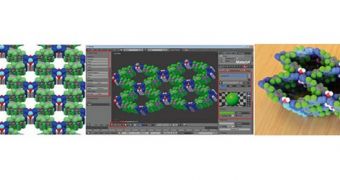It will take a decade or two for 3D printing technology to advance far enough that we can create crystals in hours, but scientists at the University of Houston have already taken the main step in that direction.
Which is to say, they have developed a method that allows them to use a 3D printer to make crystalline structures.
Normally, a CIF file (the typical format for crystallographic file storage) needed an abstruse path in order to be successfully 3D printed.
In layman terms, it was pretty hard to 3D print a crystalline structure before. The new method, though, only needs you to run a CIF file through Mercury (software commonly used by crystallographers), then through Blender (3D graphics product commonly used for animated films) and then send the file to a 3D printer.
The new method is more streamlined, and didn't even need much software coding. The new program runs on standard operating system and will let scientists see a 3D structure and twist it around during their studies.
You might notice the multi-colored nature of the structure. It's owed to the use of full color sandstone as 3D printing material.
The team of researchers that figured it all out was led by one Ognjen Miljanić, who hopes that his step-by-step means of 3D printing crystalline structures will help everyone researching the same things as him.
One might say that it's not that much of an improvement over looking at the structures on a computer screen, but it can't be denied that some people are just more hands-on than others.
Besides, it's not like a whole group of scientists and (under)grad students should be content with clustering in front of a monitor screen.
Which brings us to the potential of the new breakthrough. It's not game-changing, not really, but it will allow for easier teaching and group activities. Complex conformational structures could also benefit from being made more fun.
“The application here is potentially most interesting for teaching or outreach activities where high quality, vibrant models can be used to convey understanding of complex conformational structures in a fun and engaging way,” said James Bannock, a researcher at the Centre for Plastic Electronics at Imperial College London.
As you can see, the new 3D printing method is already gaining support worldwide. Simon Leigh, a 3D printing expert at the University of Warwick, is another pro-speaker, since it lets researchers “get right in amongst the structures and see what’s going on rather than just looking at them on a computer screen.”

 14 DAY TRIAL //
14 DAY TRIAL //